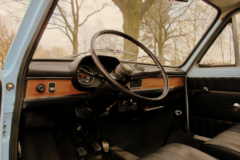Using existing technology and housing it in a new, contemporary and modern jacket. In fact, that was the starting point in the design of the Fiat 127, which is shown to the world in March 1971. This Italian supermini from the seventies stands on an enlarged platform of the also popular A112 from 1969. This creation of the Milanese Autobianchi - founded in 1955 by Bianchi, Fiat and Pirelli and wholly owned by Fiat since 1968 - has platform and chassis in technical sense also closely related to the Fiat 128, which was introduced in the same year as the A112.
Both Italians - launched at the end of the 1960s - are equipped with a power source that is placed transversely in the front. The transmission is located next to the power source. In combination with the front-wheel drive, this offers great opportunities for creating space for passengers and luggage. In fact, those principles stem from a further past. The Primula, developed by Autobianchi - widely regarded as the driving force for the Fiat 128 - is in 1964 the first car where this interplay of engine, transmission and front-wheel drive is applied in this way. In 1971, these principles are also reflected in the Fiat 127, which was co-developed by Pio Manzù.
Technical family traits
In addition, the Fiat 127 shares various applications of the Fiat 128 and the A112, the numbers one and two in the 1970 Car of the Year election. Examples of those technical applications are of course the construction method of transmission and transverse power source, the four independently suspended wheels, a stabilizer at the front, Mac Pherson struts and the transverse leaf spring at the rear, which also has a stabilizer function. The “big little three” also share the platform properties.
Young and old provide a strong range
The Fiat 128 sings its own song motorically. But the Autobianchi A112 and the Fiat 127 share the same “Fiat 100” engine with an 903 cc capacity. That power source comes from the latest series of the Fiat 850 Sport. The engine, which in the early years of the Fiat 127 47 PK on the crankshaft, makes the 127 faster than many competitors. A few mid-sized classics with basic motorization are also completely out of line with the Fiat that was fast for its time. The space offer is another strong point of the 1972 Car of the Year. With its big brother Fiat 128, the Fiat 127 shares the 20% / 80% concept: The largest part is for the benefit of the occupants and the luggage space. The Autobianchi A112, the Fiat 127 and the Fiat 128 are not only subcutaneous, but also visibly related to each other.
Arrival of three-door and Special
The first generation of the Fiat 127 is built from 1971 to 1977. The Fiat 127 debuts in a two-door trim. In the front is the 903 cc engine that places 47 PK on the crankshaft. For the model year 1973, the primal 127 will get a three-door brother. From the outset, the Fiat appears to be a success. That is a reason for Turin to barely adjust generation one of the 127 during its term. In 1974 the small delivery range of the 127 is expanded with the luxury Special, which was recognizable by the use of chrome accents. At the same time, Fiat is changing the rear window for the two-door version. It runs longer from the 1975 model year and has corners at the bottom.
Adapted power, small facelift
From that moment on, the 127 - following other markets - will also be delivered with a 45 HP engine in the Netherlands. For some markets, the 127 is also offered with a 40 HP power source. A few detail changes, such as a Special-derived grille with Wybertjes logo, control levers and other wheel covers, take the first generation of the 127 to the end. The transition model had both the “N” and the Special version.
Loved and built internationally
The Car of the Year 1972 is succeeded in 1977 by the second generation, which clearly distinguishes itself but still remains recognizable as 127. Incidentally, Seat also produces the 127 for years. The Spaniards are adding a four-door version, which in our country is only sold during the delivery of generation one as Fiat 127 4-d. Finally, it is worth noting that Polski Fiat also builds the first generation of the 127, among other things. It runs in the former Eastern Block as 127 p of the band and is made from parts of both Italian and Polish manufacture. Millions of copies sold and the extensive license construction underline the proof that the Fiat 127 concept was a bull's-eye for the car manufacturer from Turin. The first generation (together with its successor) was one of the Superminis of the seventies for a reason.










I once bought a bright yellow 400 for 127 guilders with a MOT for another year. The rust holes fell in, it always reeked of gasoline and you could fry eggs in the summer on the black skai. But what a joy to tear through Amsterdam with this scrap heap. In cold weather you had to operate the gearbox with a lot of feeling, but when it was warm it was a “Mini-Ferrari”. Very nice
Very nice cart, a good friend of my parents from Italy used to have one of the 1a seria in the dark (almost army) green.
I also wonder for a while whether and when the Nuova127 finally comes out, I think that is absolutely cool !!
https://static.allaguida.it/allaguida/fotogallery/767X0/155957/nuova-fiat-127.jpg